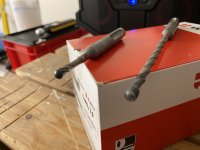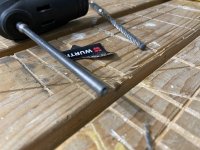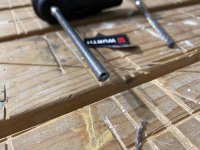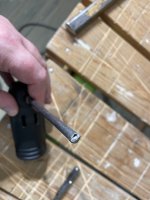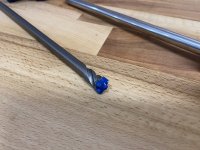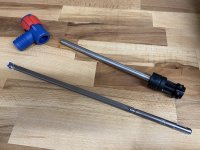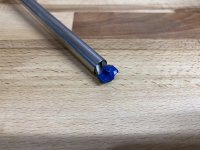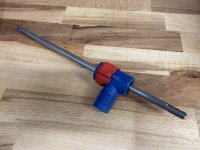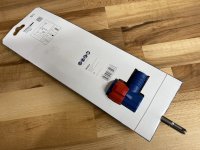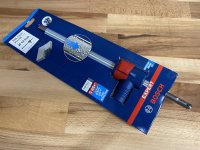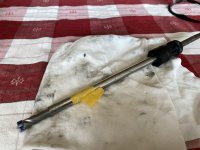six-point socket II
Member
- Joined
- Jun 26, 2016
- Messages
- 2,232
Today I want to share a bit of my experience with dust extraction drill bits. Not that I really have the time at the moment, but I called it a day early today, after learning that I will get a delivery of building materials tomorrow, which gives me some spare time for a tool related post.
So I love dust extraction drill bits ever since I first learned about them - over time however I also learned that these can be real divas/ high maintenance and somewhat picky - especially the small(er) diameter drill bits.
My "go to" dust extraction drill bit has been the Heller Duster Expert, the SDS-plus type is available from 6mm diameter & upwards.
It has a carbide head with two edges, the 6mm variant has one extraction hole on the face of the head (larger diameters have two extraction holes on the face of the head) and it's for dry concrete without rebar. For these drill bits to work well and also not overheat it is incredibly important that the dust extraction holes and channels are not obstructed. When that happens you will hear a change of noise and hear & feel how the drill bit is not running freely anymore. At that point a full stop is necessary immediately or you destroy the drill bit and "the needle becomes your friend". You need to unblock the hole(s) on the face of your drill bit. Be aware and highly cautious that the drill bit will be extremely hot, hotter than any regular SDS-plus drill bit.
I've had to clear the hole(s) regularly but actually never had a blocked channel.
If you drill a hole without the dust extractor running, the drill bit is more or less ruined immediately it can't cope with the extreme heat.
If you hit rebar with the 2 edge variants two things can happen:
1) if you have a direct/ true hit it will not go through/ you will notice and have the chance to stop.
2) if you have just a partial hit it's very likely the carbide head will (partly) shear off the body of the drill bit the second it tilts/twists. (Especially if the drill bit has already seen quite a bit of use.)
So here is a great example of a well used dust extraction drill bit, Heller Duster Expert 6mm - shortly before its lifetime had expired.
[attachimg=1]
[attachimg=2]
[attachimg=3]
And expired.
[attachimg=4]
So besides the hole-clearing, what do I mean by high-maintenance and these drill bits being picky. You can extend the lifetime of these drill bits by using a rotary hammer that is capable of running at reduced hammer blow/ impact energy. There aren't many these days that can do it, and you're in no way obligated to do this, the manual clearly lists max. allowed blow/impact energy for the different diameter drill bits and thats fully within the range of typical 2kg class rotary hammers speaking especially of the 6/8mm diameter drill bits - from 10mm upwards it's even less of an issue.
Since I needed a replacement for the 6mm drill bit, and I knew Milwaukee (Germany) had released their "Dust-Lok" (TM) dust extraction drill bit set going even smaller, now down to a 5mm dust extraction drill bit - I was intrigued and wanted to know more.
Milwaukee Dust-Lok on the German Milwaukee Tools website:https://de.milwaukeetool.eu/de-de/sds-plus-dust-lok-absaugbohrer-4-schneiden-variosystem/?variant=-1
I was able to find out that this system is manufactured in Germany by DreBo - a well known and reputable manufacturer of drill bits.
DreBo website:https://www.drebo.de/en/
Sure enough the set also became available through one of my suppliers (Würth) and I bought it - along with a Heller Duster Expert 6mm dust extraction drill bit replacement labeled from the same supplier. (In case you don't know, certified SDS-plus drill bits come with a "PGM" code that identifies the manufacturer, so it's fairly easy to identify said manufacturers, as long as you have the list to de-code. PGM stands for Prüfgemeinschaft Mauerbohrer e.V. (PGM Masonry Drill Bit Certification Board) they even have their own site where they elaborate on said "secrecy".https://pgm.eu/kennzeichnung-von-pgm-bohrern
But obviously that doesn't really fly in todays day and age, here's the most comprehensive list that I know of to decode:
https://www.werkzeug-news.de/threads/liste-der-pgm-nummer-kennzeichung-gesucht.40967/
So why is the DreBo interchangeable dust extraction drill bit set so interesting?
1) dust extraction holes are placed on the sides of the carbide head, inside open, easy to clean, channels. This means you are not actively hammering the dust into the holes as you do on extraction drill bits that have the hole(s) on the face of of the head. This is highly likely what allows them to go actually down to the 5mm diameter drill bit.
2) the drill bits are much easier to change, because you don't have to pull them from the sealed rubber housing/ dust extractor connector. They have their own, locking, interface to change between sizes. Note that it is possible to run the other dust extraction drill bits as a "set" with a single connector as well, but as stated, changing between sizes is not as easy/ effortless as with the new DreBo set.
3) they have a carbide head with 4 edges. Cope with hitting rebar much better and are not as easily sheared off.
To me that easily justifies the upgrade, especially if you used any dust extraction drill bit once, especially during overhead work, you never look back.
4) replacing worn/ broken sizes is cheaper & faster.
So let's take a look.
[attachimg=5]
[attachimg=6]
10mm Duster Expert (two holes on the face of the head), 6mm DreBo (two holes inside channels on the side of the head), 6mm Duster Expert (one hole on the face the head) and the expired 6mm Duster Expert.
[attachimg=7]
10mm Duster Expert, 6mm DreBo, 12mm DreBo - for clear visualizing of the channels and holes.
[attachimg=8]
DreBo interface/ interchangeability.
[attachimg=9]
DreBo set closeup.
[attachimg=10]
My current view on these is that the holes inside channels on the side of the head is a true milestone for small diameter dust extraction drill bits, makes life so much easier. I would have understand if people were put off by the "high maintenance"/ diva'esque behavior of small dust extraction drill bits with holes on the face, as it is a true time killer.
Otherwise, same rules apply: dry concrete only - and while they can cope with rebar much better, I wouldn't recommend them to be used to drill through rebar.
Kind regards,
Oliver
So I love dust extraction drill bits ever since I first learned about them - over time however I also learned that these can be real divas/ high maintenance and somewhat picky - especially the small(er) diameter drill bits.
My "go to" dust extraction drill bit has been the Heller Duster Expert, the SDS-plus type is available from 6mm diameter & upwards.
It has a carbide head with two edges, the 6mm variant has one extraction hole on the face of the head (larger diameters have two extraction holes on the face of the head) and it's for dry concrete without rebar. For these drill bits to work well and also not overheat it is incredibly important that the dust extraction holes and channels are not obstructed. When that happens you will hear a change of noise and hear & feel how the drill bit is not running freely anymore. At that point a full stop is necessary immediately or you destroy the drill bit and "the needle becomes your friend". You need to unblock the hole(s) on the face of your drill bit. Be aware and highly cautious that the drill bit will be extremely hot, hotter than any regular SDS-plus drill bit.
I've had to clear the hole(s) regularly but actually never had a blocked channel.
If you drill a hole without the dust extractor running, the drill bit is more or less ruined immediately it can't cope with the extreme heat.
If you hit rebar with the 2 edge variants two things can happen:
1) if you have a direct/ true hit it will not go through/ you will notice and have the chance to stop.
2) if you have just a partial hit it's very likely the carbide head will (partly) shear off the body of the drill bit the second it tilts/twists. (Especially if the drill bit has already seen quite a bit of use.)
So here is a great example of a well used dust extraction drill bit, Heller Duster Expert 6mm - shortly before its lifetime had expired.
[attachimg=1]
[attachimg=2]
[attachimg=3]
And expired.
[attachimg=4]
So besides the hole-clearing, what do I mean by high-maintenance and these drill bits being picky. You can extend the lifetime of these drill bits by using a rotary hammer that is capable of running at reduced hammer blow/ impact energy. There aren't many these days that can do it, and you're in no way obligated to do this, the manual clearly lists max. allowed blow/impact energy for the different diameter drill bits and thats fully within the range of typical 2kg class rotary hammers speaking especially of the 6/8mm diameter drill bits - from 10mm upwards it's even less of an issue.
Since I needed a replacement for the 6mm drill bit, and I knew Milwaukee (Germany) had released their "Dust-Lok" (TM) dust extraction drill bit set going even smaller, now down to a 5mm dust extraction drill bit - I was intrigued and wanted to know more.
Milwaukee Dust-Lok on the German Milwaukee Tools website:https://de.milwaukeetool.eu/de-de/sds-plus-dust-lok-absaugbohrer-4-schneiden-variosystem/?variant=-1
I was able to find out that this system is manufactured in Germany by DreBo - a well known and reputable manufacturer of drill bits.
DreBo website:https://www.drebo.de/en/
Sure enough the set also became available through one of my suppliers (Würth) and I bought it - along with a Heller Duster Expert 6mm dust extraction drill bit replacement labeled from the same supplier. (In case you don't know, certified SDS-plus drill bits come with a "PGM" code that identifies the manufacturer, so it's fairly easy to identify said manufacturers, as long as you have the list to de-code. PGM stands for Prüfgemeinschaft Mauerbohrer e.V. (PGM Masonry Drill Bit Certification Board) they even have their own site where they elaborate on said "secrecy".https://pgm.eu/kennzeichnung-von-pgm-bohrern
But obviously that doesn't really fly in todays day and age, here's the most comprehensive list that I know of to decode:
https://www.werkzeug-news.de/threads/liste-der-pgm-nummer-kennzeichung-gesucht.40967/
So why is the DreBo interchangeable dust extraction drill bit set so interesting?
1) dust extraction holes are placed on the sides of the carbide head, inside open, easy to clean, channels. This means you are not actively hammering the dust into the holes as you do on extraction drill bits that have the hole(s) on the face of of the head. This is highly likely what allows them to go actually down to the 5mm diameter drill bit.
2) the drill bits are much easier to change, because you don't have to pull them from the sealed rubber housing/ dust extractor connector. They have their own, locking, interface to change between sizes. Note that it is possible to run the other dust extraction drill bits as a "set" with a single connector as well, but as stated, changing between sizes is not as easy/ effortless as with the new DreBo set.
3) they have a carbide head with 4 edges. Cope with hitting rebar much better and are not as easily sheared off.
To me that easily justifies the upgrade, especially if you used any dust extraction drill bit once, especially during overhead work, you never look back.
4) replacing worn/ broken sizes is cheaper & faster.
So let's take a look.
[attachimg=5]
[attachimg=6]
10mm Duster Expert (two holes on the face of the head), 6mm DreBo (two holes inside channels on the side of the head), 6mm Duster Expert (one hole on the face the head) and the expired 6mm Duster Expert.
[attachimg=7]
10mm Duster Expert, 6mm DreBo, 12mm DreBo - for clear visualizing of the channels and holes.
[attachimg=8]
DreBo interface/ interchangeability.
[attachimg=9]
DreBo set closeup.
[attachimg=10]
My current view on these is that the holes inside channels on the side of the head is a true milestone for small diameter dust extraction drill bits, makes life so much easier. I would have understand if people were put off by the "high maintenance"/ diva'esque behavior of small dust extraction drill bits with holes on the face, as it is a true time killer.
Otherwise, same rules apply: dry concrete only - and while they can cope with rebar much better, I wouldn't recommend them to be used to drill through rebar.
Kind regards,
Oliver
Attachments
-
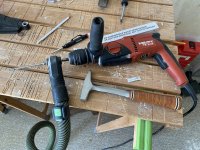 IMG_7757.jpg389.7 KB · Views: 1,892
IMG_7757.jpg389.7 KB · Views: 1,892 -
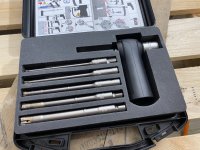 IMG_8187.jpg298.2 KB · Views: 1,736
IMG_8187.jpg298.2 KB · Views: 1,736 -
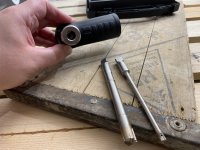 IMG_8184.jpg268.4 KB · Views: 1,757
IMG_8184.jpg268.4 KB · Views: 1,757 -
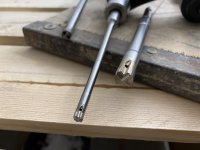 IMG_8182.jpg150.2 KB · Views: 1,765
IMG_8182.jpg150.2 KB · Views: 1,765 -
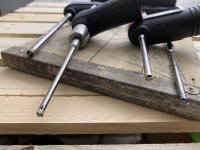 IMG_8180.jpg201.4 KB · Views: 1,762
IMG_8180.jpg201.4 KB · Views: 1,762 -
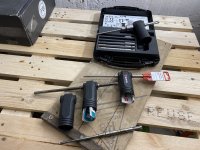 IMG_8179.jpg301.9 KB · Views: 1,782
IMG_8179.jpg301.9 KB · Views: 1,782 -
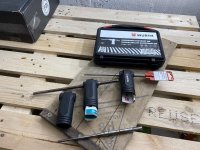 IMG_8178.jpg305 KB · Views: 1,818
IMG_8178.jpg305 KB · Views: 1,818 -
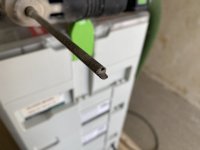 IMG_7761.jpg95.6 KB · Views: 1,857
IMG_7761.jpg95.6 KB · Views: 1,857 -
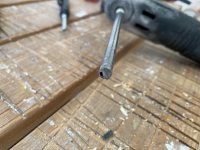 IMG_7759.jpg174.5 KB · Views: 1,884
IMG_7759.jpg174.5 KB · Views: 1,884 -
 IMG_7758.jpg189.1 KB · Views: 1,868
IMG_7758.jpg189.1 KB · Views: 1,868


